
The Project Gutenberg EBook of White House China of the Lincoln Administration in the Museum of History and Technology, by Margaret Brown Klapthor This eBook is for the use of anyone anywhere at no cost and with almost no restrictions whatsoever. You may copy it, give it away or re-use it under the terms of the Project Gutenberg License included with this eBook or online at www.gutenberg.org Title: White House China of the Lincoln Administration in the Museum of History and Technology Author: Margaret Brown Klapthor Release Date: May 10, 2011 [EBook #36082] Language: English Character set encoding: ISO-8859-1 *** START OF THIS PROJECT GUTENBERG EBOOK WHITE HOUSE CHINA *** Produced by Chris Curnow, Joseph Cooper and the Online Distributed Proofreading Team at http://www.pgdp.net

United States National Museum Bulletin 250
Contributions from
The Museum of History and Technology
Paper 62, pages 109-120
WHITE HOUSE CHINA OF THE LINCOLN ADMINISTRATION
in the Museum Of History And Technology
Margaret Brown Klapthor
Smithsonian Press
Washington, D.C.
1967
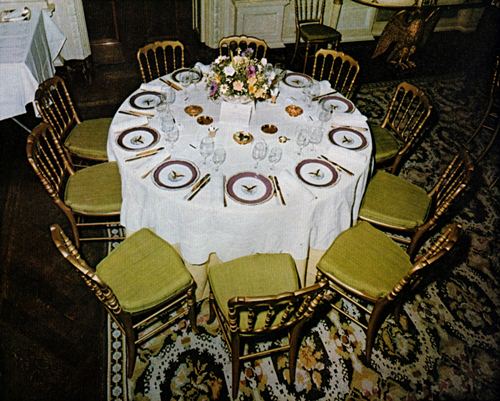
WHITE HOUSE COLLECTION
Figure 1: A table setting showing the Lincoln
china being used for a luncheon
during the administration of President Lyndon B. Johnson.
Margaret Brown Klapthor
WHITE HOUSE CHINA
OF THE
LINCOLN ADMINISTRATION
In the Museum of History and Technology
This article on the china of the administration of President Abraham Lincoln is intended to be the first of a series of articles on Presidential china based on the collection in the Smithsonian Institution. From contemporary records in National Archives, newspaper articles and family records it is our hope to assemble material which will ultimately present the story of White House and Presidential china of every administration. Myths and facts surrounding this interesting topic will be examined and presented to assist the many collectors of this porcelain as well as others who admire and appreciate its historical interest.
In this first article, the author describes the efforts of Mrs. Abraham Lincoln to acquire porcelain suitable for official entertaining in the White House.
The Author: Margaret Brown Klapthor is associate curator of political history in the Smithsonian Institution’s Museum of History and Technology.
When Mrs. Lincoln arrived at the White House in 1861 she found the pantry sadly deficient in elegant tableware to set a State dinner. The last official State service had been purchased by the White House during the administration of President Franklin Pierce (it is the china known popularly as the “red edge” set), and not enough of that was left to serve a large dinner party.
Theodore R. Davis, who designed the State china purchased during the administration of President Rutherford B. Hayes, wrote an article, published in the May 1899 issue of the Ladies’ Home Journal, on the “Presidential Porcelain of a Century.” He records that in 1860 he saw the State Dining Room of the White House set up for the formal dinner given [Pg 112]for the visiting Prince of Wales, and that “the dishes were more or less odd, but generally comprised what was known as the ‘red edge set’.”
Chinaware was not the only thing needed in the Executive Mansion in the opinion of Mary Todd Lincoln. Fortunately for her, Congress was accustomed to appropriating $20,000 to refurnish the President’s House to the taste of each new First Lady. This money became available to her when the special session was convened in April 1861, and Mrs. Lincoln set out the next month on a shopping trip to New York and Philadelphia. She was accompanied by a favorite cousin, Mrs. Elizabeth Todd Grimsley, who had come to Washington for the inauguration in March and stayed on at the White House with the Lincolns for six months.
The ladies’ arrival in New York City on May 12, was duly noted in the city newspaper. On May 16, 1861, The New York Daily Tribune records under the heading Personal:
Mrs. Lincoln employed the greater portion of Wednesday forenoon in making purchases. Among other places she visited the establishments of Lord & Taylor, and Messrs. E. V. Haughwout and Co. At the latter establishment she ordered a splendid dinner service for the White House in “Solferino” and gold with the arms of the United States emblazoned on each piece. The purchases also include some handsome vases and mantle ornaments for the blue and green rooms.
The firm of E. V. Haughwout and Co. whose bill head identifies it as “Importers and Decorators of French China” was accustomed to Executive Mansion patronage. Under the name of Haughwout and Dailey they had sold a dinner service to President Pierce in 1853.[1] During Mrs. Lincoln’s May visit, Haughwout’s must have shown her a handsome specimen plate they had exhibited at the Crystal Palace Exhibition in New York in 1853 which had been made for President Pierce’s approval. A picture of the plate in the Haughwout and Dailey display is shown in the catalog of the Exhibition where it is identified as “a specimen plate of a dinner service manufactured for the President of the United States with the American eagle and blue band in Alhambra style.”[2] President Pierce evidently did not like the design as the service he subsequently purchased from Haughwout and Dailey had a plain red band and was not the one manufactured for his approval and exhibited in New York.
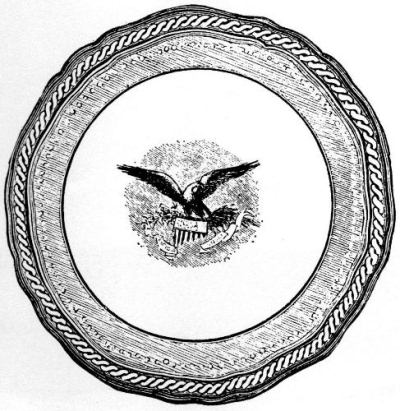
Figure 2.—Plate illustrated in the catalog of the Crystal Palace Exhibition, 1853. (Smithsonian photo 60016.)
Mary Todd Lincoln was delighted with the plate displayed at the Crystal Palace Exhibition and ordered a complete dinner service of that design. Her only change was to have a wide “Solferino” border painted on the service instead of the blue border specified for the 1853 plate. This bright purplish-red color had become extremely fashionable since its discovery in 1859, and it provided another variation of Mrs. Lincoln’s favorite color, which she indulged in personal attire as well as in room decor.
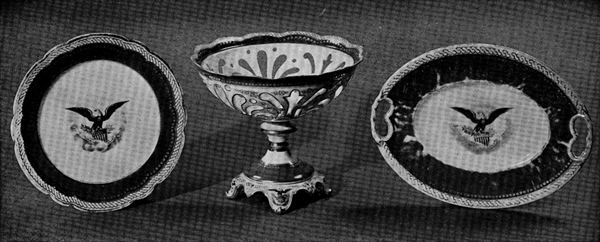
Figure 3.—Plate, compote, and small platter from the purple-bordered State china used during the administration of President Abraham Lincoln, (USNM ace. 221233; Smithsonian photo 48115-A.)
Mrs. Lincoln probably first saw and gave her approval to the elegant new china when she returned to New York for more shopping in August. The china was delivered on September 2, 1861, with a bill itemized as follows:[3]
One fine Porcelain Dining Service of One Hundred, and ninety pieces ... 190 ... decorated Royal purple, and double gilt, with the Arms of the United States, on each piece, for the Presidential Mansion ... namely ...
| Two Bowls for Salad |
| Four Shells do Pickles |
| Four Meat Platters 9 inch |
| Four do do 10 do |
| Four do do 13 do |
| Two do do 15 do |
| Two do do 18 do |
| Two do do 20 do |
| Four Fish do various sizes, and forms |
| Two Butter Dishes, with drainers, and covers. |
| Six uncovered vegetable dishes or bakers. |
| Ninety-six Dinner Plates 9 inch |
| Forty-eight Soup do 9 do |
| Four Large Water Pitchers. |
| Two Bowls for Ice. |
| Eleven Hundred, and ninety-five dollars. |
One fine Porcelain Dessert Service, consisting of Two hundred and eight pieces ... 208 ... richly decorated to match Dining Set ... namely.
| Two Stands for Custard Cups |
| Thirty-six do do |
| Eight High Comportiers for fruit. |
| Two do do large do do |
| Four shell do |
| Two Bowls for Strawberries |
| Two Dessert Sugars |
| Six Round High Baskets for fruit. |
| Two Oval do do do do |
| Sixty Dessert Plates 8 inch |
| Thirty-six after Dinner Coffees. |
| Eight Hundred, and thirty-seven dollars. |
One fine Breakfast, and Tea Service, containing Two Hundred, and sixty pieces, richly decorated to match Dinner Service ... namely.
| Forty-eight Tea Plates 6½ inch |
| Thirty-six Preserve do 4½ do |
| Thirty-six Coffees for Breakfast |
| Twenty-four Egg Cups |
| Thirty-six Teas |
| Eight Plates for Cake |
| Seven Hundred, and fifty nine dollars. |
Four Small Sevres Centre Pieces for Bon Bons, decorated to match Dinner Service @ Twenty-five = One Hundred Two Large Centre Pieces, Sevres, supported by “White Pelicans and decorated to match dinner service
| @ One Hundred = Two Hundred |
| Two Punch Bowls, decorated to match dinner service |
| @ Fifty = One Hundred |
| Packages Four Dollars |
| Total Amount |
| Three Thousand, one Hundred and Ninety-five dollars. |
The picture of the design presented for President Pierce’s inspection in 1853 which appears in the catalog of the New York Crystal Palace Exhibition[4] is proof of the readiness with which symbolism is read into a design which came into existence long[Pg 114] before the symbol is appropriate. Writing in 1895 Edwin Atlee Barber says of the Lincoln China that the design for the decoration, selected after much consultation among officials at Washington, was added in New York by the importer. It consisted of a spirited rendering of the arms of the United States—the American eagle mounted on the national shield and beneath it the motto E Pluribus Unum. This design was engraved and then transferred to the china as an outline to be filled in with color. The border of the plate, a gold guilloche, or cable, of two strands entwined and, thus, mutually strengthening each other, was intended to signify the union of the North and South.[5] The same idea was meant to be conveyed in the central design: “Though clouds surround our Country, the sunlight is breaking through.” The explanation of the symbolism of the design, while appropriate for the Lincoln Administration, could hardly have been true for the china which was originally designed for Presidential use in 1853.
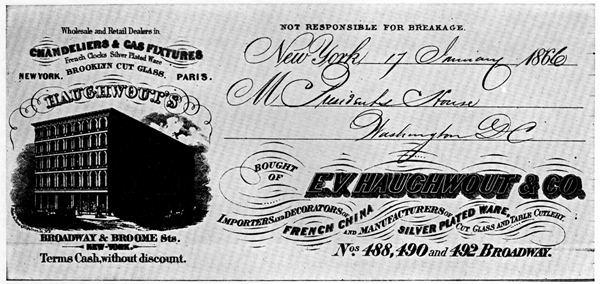
Figure 4.—Letterhead of E. V. Haughwout & Co., from whom the purple set was ordered. (Smithsonian photo 60001-A.)
Tradition identifies the blanks on which the design of the Lincoln china was painted as being imported from the Haviland factory in Limoges, France. The original china bears no maker’s mark, however, as this was more than ten years before the Haviland factory started to mark their ware.[6] The earliest positive link of the Lincoln china to Haviland and Company seems to be an affidavit which Theodore R. Davis attached to a Lincoln plate in 1881 saying “This plate One of the Lincoln Set made by Haviland & Co. was used by President Garfield when upon his death bed. The plate was broken in bringing it from the President’s room and was given by Wm. Crump to Theo. R. Davis Sept. 1881.” The plate is now in the collections of the State Historical Society of Wisconsin. It is possible that Theodore Davis,[Pg 115] a personal friend of Theodore Haviland, had derived directly from Mr. Haviland this manufacturer identification of the china which Haughwout decorated.
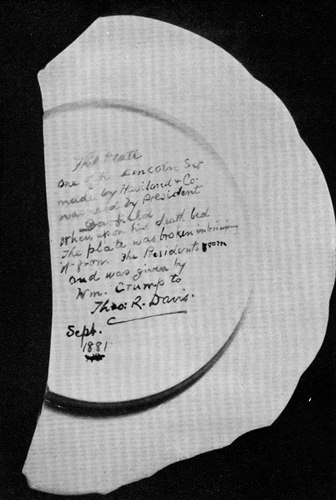
Figure 5.—Lincoln plate which bears affidavit of Theodore R. Davis. (Courtesy of the State Historical Society of Wisconsin.)
The official dinner service so delighted Mrs. Lincoln that she ordered a similar set for herself. On the personal service the initials “M. L.” were substituted for the arms of the United States as decoration. Mrs. Grimsley says “... this latter, I know, was not paid for by the district commissioner, as was most unkindly charged when it was stored away.”[7] It has been suggested that the personal china was paid for by a withdrawal of $1106.73 from the President’s account with the bank of Riggs and Co.

Figure 6.—Custard cup From the Purple-Bordered State China used during the administration of President Abraham Lincoln. (USNM acc. 206542; Smithsonian photo 44120-G.)
The personal china was an indiscreet purchase, at best, and Mrs. Lincoln was soon accused of buying the china out of public funds. In the midst of the campaign in which Lincoln ran for re-election in 1864 an opposition newspaper, The New York World, published a bitter attack on the President and his wife charging that the bill submitted by Haughwout for the State service had been padded to include the cost of the personal china.[8] According to the paper’s editorial, the deceit was discovered when the amount of the bill was questioned by a clerk in the Treasury Department and “Honest Abe,” when cornered, made payment out of his own pocket. This story seems to be refuted by the evidence on the Haughwout bill, which was signed by the Comptroller for payment on September 16, 1861, within two weeks after the china was received, and only three after President Lincoln had approved the bill.
The extent to which this controversy spoiled Mrs. Lincoln’s pleasure in the handsome purple service perhaps can be measured by the fact that after President Lincoln was re-elected, she purchased another large china service for the White House. A bill, recently discovered at the National Archives,[Pg 116] documents the new set as being ordered by Mrs. Lincoln from J. K. Kerr of 529 Chestnut Street, Philadelphia, whose establishment, known as China Hall, specialized in French and English china and glassware. Dated January 30, 1865, the bill was for:[9]
1 Extra Large French China, Dining, Dessert and Coffee Service, decorated on a White ground, delicate Buff Border with burnished Gold lines consisting of the following pieces.
| 12 | Dozen Dining plates | ||
| 6 | Dozen Soup plates | ||
| 6 | Dozen Dessert plates | ||
| 6 | Dozen Ice Cream, or peaches & cream plates deep | ||
| 1 | Large dish for head of table | ||
| 1 | Foot dish | ||
| 2 | Second course head & foot dishes | ||
| 2 | more dishes | ||
| 2 | more dishes | ||
| 2 | more dishes | ||
| 4 | vegetable dishes with covers | ||
| 4 | more vegetable dishes with covers | ||
| 4 | Sauce tureens | ||
| 4 | Sauce Boats | ||
| 4 | Stands for Sauce Boats | ||
| 4 | Pickle Shells | ||
| 2 | Salad Bowls | ||
| 2 | Custard Stands | ||
| 48 | Custard Cups with covers | ||
| 2 | Large rich oval fruit Baskets | ||
| 4 | Smaller round do | ||
| 4 | Fruit Comports Shell form for fruit | ||
| 4 | do do high round | ||
| 2 | Dessert Sugar bowls with covers | ||
| 48 | After Dinner Coffee Cups & Saucers | ||
| 1 | Large Dish for Fish | $1700 |
Records show that the china was brought to Washington by Harnden Express, as there is a voucher “For freight on 5 casks from Philadelphia, Pennsylvania to Washington, D.C., mkd Mrs. A. Lincoln $28.50. China from J. Kerr Phila. Pa. for dinner.” It is signed “J. K. Kerr” “Mrs. Lincoln” and is dated February 13, 1865.[10]
Two weeks later, on February 28, Kerr sent a bill for some additions to the service as follows:[11]
| 2 | Dozen Coffee Cups & Saucers | |||
| Delicate Buff Border & Gilt | 20.00 | 40.00 | ||
| 4 | Water pitchers do do | 10.00 | 40.00 | |
| 4 | do smaller do do | 8.00 | 32.00 | |
| 4 | do do do do | 6.00 | 24.00 | |
| 4 | do do do do | 5.00 | 20.00 | |
| 6 | bowls do do | 2.50 | 15.00 | |
| Package | 2.50 | |||
| 173.50 |
Two months later President Abraham Lincoln was assassinated. The china so recently ordered could hardly have been used by Mrs. Lincoln, and evidently payment had not been made, for it is recorded that at one of the first conferences which B. B. French, Commissioner of Public Buildings and Grounds, had with President Johnson in April 1865, he sought the President’s approval of payment for a purchase of china by Mrs. Lincoln.[12]
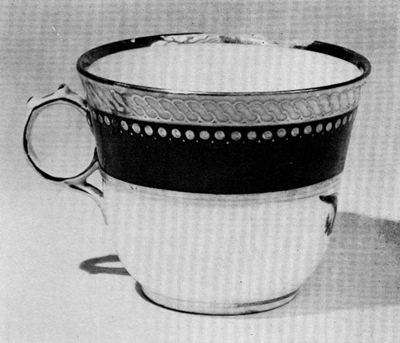
Figure 7:—Coffee cup From the Purple-Bordered State China used by President Abraham Lincoln at dinner at the White House on the night of his assassination. (USNM acc. 219098; Smithsonian photo 45088-D.)
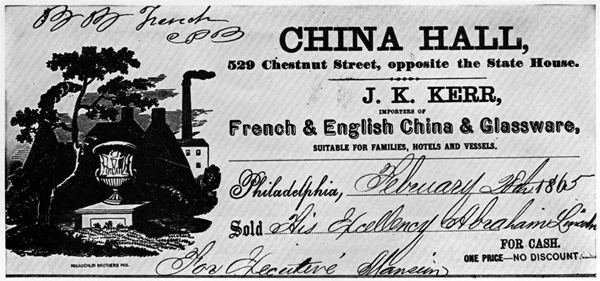
Figure 8.—Letterhead of J. K. Kerr, from whom the buff set was ordered. (Smithsonian photo 60001-B.)
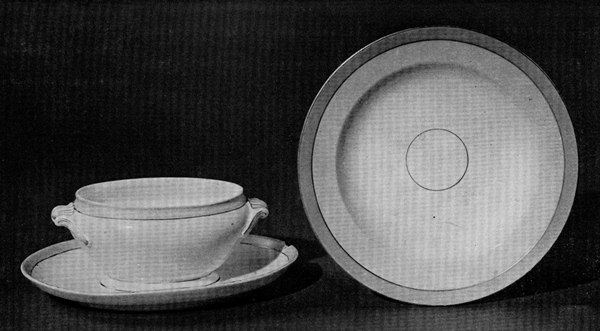
Figure 9.—Gravy boat and soup bowl from the buff-bordered French porcelain ordered by Mrs. Lincoln for the White House in 1865. (USNM acc. 228204; Smithsonian photo 48115-Y.)
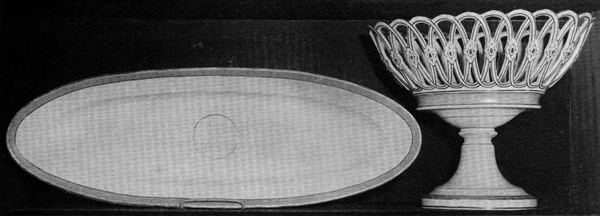
Figure 10.—Pieces from the buff-bordered service displayed in the China Room in the White House. (Photo by Abbie Rowe, courtesy National Park Service.)
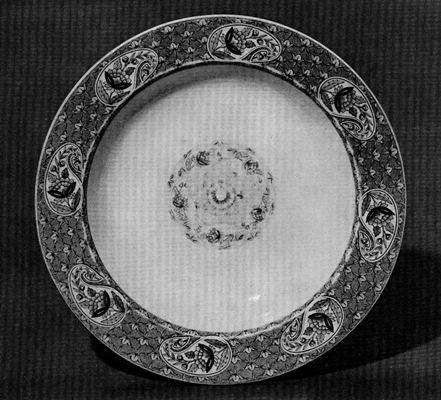
Figure 11.—Soup bowl from the Royal Worcester service used at the summer White House at the Soldiers’ Home during the administration of President Abraham Lincoln. (USNM acc. 228204; Smithsonian photo 48115-F.)
Despite Commissioner French’s concern, the account was not completely settled until a year after the china had been delivered. The first bill is receipted as paid[Pg 119] on August 29, 1865, at which time it was endorsed “Received from B B French C. P. Bgs the above amnt of Two thousand three hundred & thirty two dollars in full of this account.” (The difference between this amount and that given above is accounted for by the fact that the original order included 4 dozen goblets and 28 dozen wineglasses of various sizes, costing a total of $632.50.) The second bill was paid on February 10, 1866.
The inventory made when Mrs. Lincoln turned over the White House to President Johnson lists under china and glassware “One full set China,” which was certainly this buff and gold service, and “3 small remnants of china sets nearly all broken up,” which must have included the remaining pieces of the royal-purple service.[13]
Evidently, the Johnsons decided to use the purple china, because we find that in less than a year they ordered replacement pieces for it. A bill from E. V. Haughwout, dated January 17, 1866[14] lists—
To the following articles of rich China Ware with Arms & Crests of the U.S. to replace the pieces broken & lost of the Solferino sett viz
| 1 | salad dish, 4 pickles, 36 custard cups, | ||
| 24 | egg cups, 18 dishes—4/10-, 6/11-, 6/13-, 1/15-, 1/18-inch | ||
| 6 | comports 3/high, 2/low, & 1/shell | ||
| 2 | dessert sugars, 2 round baskets | ||
| 2 | butter dishes, 31 dinner plates | ||
| 57 | dessert plates, 48 tea plates | ||
| 25 | soup " , 26 preserve " | ||
| 36 | breakfast coffees, 36 black coffees | ||
| 36 | teas, 1 Cake plate, 4 pitchers | ||
| 1 | Ice bowl | 2061.25 |
Even with this second order, which almost equalled the original in size and cost, the purple set did not last; early in the administration of President Grant not enough of it was left to set the table in the State Dining Room satisfactorily. Those who handled the Lincoln set grew weary, it is said, of the constant breakage and became convinced that not careless handling but “bad luck in the china itself” was destroying both the dishes and the patience of those who were responsible for them.[15]
The story of the china associated with the Lincoln administration must also include a service used by the Lincolns at the summer White House which they maintained on the grounds of the Soldiers’ Home in Washington, D.C. Recently, the Quartermaster Corps of the Army turned over to the White House for the china collection some pieces of Royal Worcester china used in the house at the time of President Lincoln’s occupancy. It has a wide border of tiny gray and yellow flowers in a diaper design, with a multicolored floral wreath in the center of the plate. This use of English china and the informal design of the set is noteworthy, as almost every set of official china up to this time had been French, and French china continued to be used at the White House until almost the end of the 19th century.
It is appropriate in this discussion of the Lincoln china to mention the number of commemorative reproductions which were made for sale to the general public as souvenirs in the last quarter of the 19th century. The earliest of these reproduction pieces seem to be some which are marked on the back “Fabriqué par Haviland & Co./Pour/J. W. Boteler & Bro./Washington.” The firm of J. W. Boteler and Brother is first listed in the Washington City Directory in 1867 and it was in existence until 1881 when the name of the firm was changed to J. W. Boteler & Son. The dates of Boteler & Brother encompasses the period of the celebration of the Centennial of the United States in 1876. This celebration created intense interest in the Presidency and objects which symbolized the office, providing a ready market for copies of the Lincoln china. Indeed several different pieces of White House china have been brought to our attention with family legends that they were purchased at the “World’s Fair.” In each case it has been clear that the “Fair” meant the Centennial Exposition in Philadelphia in 1876. Two reproduction plates have been brought to the Smithsonian Institution for examination. On both of these the words “Administration/Abraham Lincoln” were stamped on the back in red. It is well for collectors[Pg 120] of White House china to remember that the original pieces of the Lincoln service did not bear any mark on the reverse.

Figure 12.—Drawing of the mark found, in red, on the two plates submitted to the Museum for identification.

Figure 13.—Obverse of Lincoln plate bearing the mark of J. W. Boteler and Bro. (Smithsonian photo 44120.)
The excellent quality of the pieces bearing the Boteler mark may explain a persistent legend that Edward Lycett was associated with the Lincoln service.[16] Mr. Lycett came to this country from England in 1861 and thereafter was identified with the development and expansion of the art of china painting in America until the turn of the century. Many sources credit Mr. Lycett with painting the second order of the Lincoln service on commission of John Vogt & Co. of New York City. As the records establish the fact that the second order for the china was made to E. V. Haughwout & Co., just as was the first, we can only speculate that perhaps Mr. Lycett painted the commemorative china which bears the mark of J. W. Boteler & Brother and of Haviland & Co. which is so beautifully hand painted to match the official White House china.
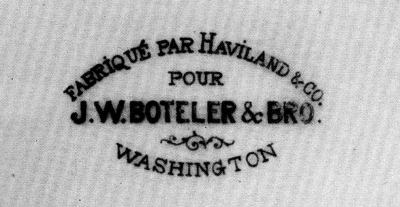
Figure 14.—Mark of J. W. Boteler & Bro. used on reverse of Lincoln plate. (Smithsonian photo 44120-L.)
In the collections of the Smithsonian’s Museum of History and Technology are the following pieces of the royal-purple set of Lincoln china:
Plate and 2-handled custard cup. Gift of Col. Theodore Barnes, (USNM accession 206542, cat. nos. 58566 and 58567).
Dinner coffee cup and saucer, gift of Mr. Lincoln Isham (USNM accession 219098, cat. no. 219098.9). This cup and saucer are the ones which were used by President Lincoln at dinner on the night of April 14, 1865, just before he attended the performance at Ford’s Theater at which he was assassinated.
The following pieces are in the Smithsonian Institution on loan from the White House (accessions 221233 and 228204).
From the purple set:
small oval platter
meat platter
3 compotes
oval fruit basket
coffee cup and saucer
water pitcher
fish platter
dinner plate
shallow bowl
soup bowl.
From the set with the buff band:
soup bowl
gravy boat.
U.S. Government Printing Office; 1967
For sale by Superintendent of Documents, U.S. Government Printing Office
Washington, D.C. 20402 Price 35 cents
Footnotes:
[1] National Archives, Record group 217, Government Accounting Office, miscellaneous Treasury accounts, receipted account 113810, voucher 4.
[2] Official catalog of the New York exhibition of the industry of all nations, 1853. New York, 1853.
[3] National Archives, record group 217, General Accounting Office, miscellaneous Treasury accounts, receipted account 141451.
[4] Loc. cit. (footnote 2).
[5] Edwin Atlee Barber, “The Pioneer of China Painting in America,” The Ceramic Monthly (September 1895), vol. 2, no. 2, pp. 15-20.
[6] Letter from Charles Haviland at Limoges, France, to Theodore Haviland in the United States dated March 4, 1869, in the archives of Haviland & Co., Inc.: “It would certainly be a good thing to stamp all our china with our name if: 1st our china was better than any one else or at least as good and 2nd if we made enough for our trade. Without that it would turn against us and learn people that by ordering through Vogt or Nittal they could get Gibus or Julieus china which is better than ours. And if ours was the best but we did not make enough to fill orders there would be a complaint when we gave other manufacturer’s china. So our first aim must be to manufacture as well or better than any body else and to make all we sell——Then & then only it will be a capital thing to stamp all our make with our name.” Their goal was finally achieved in 1876.
[7] Elizabeth Todd Grimsley, “Six Months in the White House,” Journal, Illinois State Historical Society, vol. 19, nos. 3-4, pp. 42-73.
[8] The New York World, September 26, 1864.
[9] National Archives, record group 217, General Accounting Office, miscellaneous Treasury accounts, receipted account 157178, voucher 9.
[10] Ibid., voucher 26.
[11] Ibid., voucher 25.
[12] George Fort Milton, The Age of Hate: Andrew Johnson and the Radicals (New York: Coward-McCann, Inc., 1930), p. 229.
[13] National Archives, records of Commissioner of Public Buildings and Grounds, inventory of the Lincoln Administration, 1865.
[14] Op. cit. (footnote 9), voucher 18.
[15] Theodore R. Davis, “Presidential Porcelain of a Century,” The Ladies’ Home Journal (May 1889), p. 4.
[16] Edwin Atlee Barber, loc. cit. (footnote 5).
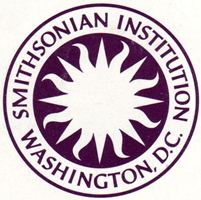
End of the Project Gutenberg EBook of White House China of the Lincoln
Administration in the Museum of History and Technology, by Margaret Brown Klapthor
*** END OF THIS PROJECT GUTENBERG EBOOK WHITE HOUSE CHINA ***
***** This file should be named 36082-h.htm or 36082-h.zip *****
This and all associated files of various formats will be found in:
http://www.gutenberg.org/3/6/0/8/36082/
Produced by Chris Curnow, Joseph Cooper and the Online
Distributed Proofreading Team at http://www.pgdp.net
Updated editions will replace the previous one--the old editions
will be renamed.
Creating the works from public domain print editions means that no
one owns a United States copyright in these works, so the Foundation
(and you!) can copy and distribute it in the United States without
permission and without paying copyright royalties. Special rules,
set forth in the General Terms of Use part of this license, apply to
copying and distributing Project Gutenberg-tm electronic works to
protect the PROJECT GUTENBERG-tm concept and trademark. Project
Gutenberg is a registered trademark, and may not be used if you
charge for the eBooks, unless you receive specific permission. If you
do not charge anything for copies of this eBook, complying with the
rules is very easy. You may use this eBook for nearly any purpose
such as creation of derivative works, reports, performances and
research. They may be modified and printed and given away--you may do
practically ANYTHING with public domain eBooks. Redistribution is
subject to the trademark license, especially commercial
redistribution.
*** START: FULL LICENSE ***
THE FULL PROJECT GUTENBERG LICENSE
PLEASE READ THIS BEFORE YOU DISTRIBUTE OR USE THIS WORK
To protect the Project Gutenberg-tm mission of promoting the free
distribution of electronic works, by using or distributing this work
(or any other work associated in any way with the phrase "Project
Gutenberg"), you agree to comply with all the terms of the Full Project
Gutenberg-tm License (available with this file or online at
http://gutenberg.org/license).
Section 1. General Terms of Use and Redistributing Project Gutenberg-tm
electronic works
1.A. By reading or using any part of this Project Gutenberg-tm
electronic work, you indicate that you have read, understand, agree to
and accept all the terms of this license and intellectual property
(trademark/copyright) agreement. If you do not agree to abide by all
the terms of this agreement, you must cease using and return or destroy
all copies of Project Gutenberg-tm electronic works in your possession.
If you paid a fee for obtaining a copy of or access to a Project
Gutenberg-tm electronic work and you do not agree to be bound by the
terms of this agreement, you may obtain a refund from the person or
entity to whom you paid the fee as set forth in paragraph 1.E.8.
1.B. "Project Gutenberg" is a registered trademark. It may only be
used on or associated in any way with an electronic work by people who
agree to be bound by the terms of this agreement. There are a few
things that you can do with most Project Gutenberg-tm electronic works
even without complying with the full terms of this agreement. See
paragraph 1.C below. There are a lot of things you can do with Project
Gutenberg-tm electronic works if you follow the terms of this agreement
and help preserve free future access to Project Gutenberg-tm electronic
works. See paragraph 1.E below.
1.C. The Project Gutenberg Literary Archive Foundation ("the Foundation"
or PGLAF), owns a compilation copyright in the collection of Project
Gutenberg-tm electronic works. Nearly all the individual works in the
collection are in the public domain in the United States. If an
individual work is in the public domain in the United States and you are
located in the United States, we do not claim a right to prevent you from
copying, distributing, performing, displaying or creating derivative
works based on the work as long as all references to Project Gutenberg
are removed. Of course, we hope that you will support the Project
Gutenberg-tm mission of promoting free access to electronic works by
freely sharing Project Gutenberg-tm works in compliance with the terms of
this agreement for keeping the Project Gutenberg-tm name associated with
the work. You can easily comply with the terms of this agreement by
keeping this work in the same format with its attached full Project
Gutenberg-tm License when you share it without charge with others.
1.D. The copyright laws of the place where you are located also govern
what you can do with this work. Copyright laws in most countries are in
a constant state of change. If you are outside the United States, check
the laws of your country in addition to the terms of this agreement
before downloading, copying, displaying, performing, distributing or
creating derivative works based on this work or any other Project
Gutenberg-tm work. The Foundation makes no representations concerning
the copyright status of any work in any country outside the United
States.
1.E. Unless you have removed all references to Project Gutenberg:
1.E.1. The following sentence, with active links to, or other immediate
access to, the full Project Gutenberg-tm License must appear prominently
whenever any copy of a Project Gutenberg-tm work (any work on which the
phrase "Project Gutenberg" appears, or with which the phrase "Project
Gutenberg" is associated) is accessed, displayed, performed, viewed,
copied or distributed:
This eBook is for the use of anyone anywhere at no cost and with
almost no restrictions whatsoever. You may copy it, give it away or
re-use it under the terms of the Project Gutenberg License included
with this eBook or online at www.gutenberg.org
1.E.2. If an individual Project Gutenberg-tm electronic work is derived
from the public domain (does not contain a notice indicating that it is
posted with permission of the copyright holder), the work can be copied
and distributed to anyone in the United States without paying any fees
or charges. If you are redistributing or providing access to a work
with the phrase "Project Gutenberg" associated with or appearing on the
work, you must comply either with the requirements of paragraphs 1.E.1
through 1.E.7 or obtain permission for the use of the work and the
Project Gutenberg-tm trademark as set forth in paragraphs 1.E.8 or
1.E.9.
1.E.3. If an individual Project Gutenberg-tm electronic work is posted
with the permission of the copyright holder, your use and distribution
must comply with both paragraphs 1.E.1 through 1.E.7 and any additional
terms imposed by the copyright holder. Additional terms will be linked
to the Project Gutenberg-tm License for all works posted with the
permission of the copyright holder found at the beginning of this work.
1.E.4. Do not unlink or detach or remove the full Project Gutenberg-tm
License terms from this work, or any files containing a part of this
work or any other work associated with Project Gutenberg-tm.
1.E.5. Do not copy, display, perform, distribute or redistribute this
electronic work, or any part of this electronic work, without
prominently displaying the sentence set forth in paragraph 1.E.1 with
active links or immediate access to the full terms of the Project
Gutenberg-tm License.
1.E.6. You may convert to and distribute this work in any binary,
compressed, marked up, nonproprietary or proprietary form, including any
word processing or hypertext form. However, if you provide access to or
distribute copies of a Project Gutenberg-tm work in a format other than
"Plain Vanilla ASCII" or other format used in the official version
posted on the official Project Gutenberg-tm web site (www.gutenberg.org),
you must, at no additional cost, fee or expense to the user, provide a
copy, a means of exporting a copy, or a means of obtaining a copy upon
request, of the work in its original "Plain Vanilla ASCII" or other
form. Any alternate format must include the full Project Gutenberg-tm
License as specified in paragraph 1.E.1.
1.E.7. Do not charge a fee for access to, viewing, displaying,
performing, copying or distributing any Project Gutenberg-tm works
unless you comply with paragraph 1.E.8 or 1.E.9.
1.E.8. You may charge a reasonable fee for copies of or providing
access to or distributing Project Gutenberg-tm electronic works provided
that
- You pay a royalty fee of 20% of the gross profits you derive from
the use of Project Gutenberg-tm works calculated using the method
you already use to calculate your applicable taxes. The fee is
owed to the owner of the Project Gutenberg-tm trademark, but he
has agreed to donate royalties under this paragraph to the
Project Gutenberg Literary Archive Foundation. Royalty payments
must be paid within 60 days following each date on which you
prepare (or are legally required to prepare) your periodic tax
returns. Royalty payments should be clearly marked as such and
sent to the Project Gutenberg Literary Archive Foundation at the
address specified in Section 4, "Information about donations to
the Project Gutenberg Literary Archive Foundation."
- You provide a full refund of any money paid by a user who notifies
you in writing (or by e-mail) within 30 days of receipt that s/he
does not agree to the terms of the full Project Gutenberg-tm
License. You must require such a user to return or
destroy all copies of the works possessed in a physical medium
and discontinue all use of and all access to other copies of
Project Gutenberg-tm works.
- You provide, in accordance with paragraph 1.F.3, a full refund of any
money paid for a work or a replacement copy, if a defect in the
electronic work is discovered and reported to you within 90 days
of receipt of the work.
- You comply with all other terms of this agreement for free
distribution of Project Gutenberg-tm works.
1.E.9. If you wish to charge a fee or distribute a Project Gutenberg-tm
electronic work or group of works on different terms than are set
forth in this agreement, you must obtain permission in writing from
both the Project Gutenberg Literary Archive Foundation and Michael
Hart, the owner of the Project Gutenberg-tm trademark. Contact the
Foundation as set forth in Section 3 below.
1.F.
1.F.1. Project Gutenberg volunteers and employees expend considerable
effort to identify, do copyright research on, transcribe and proofread
public domain works in creating the Project Gutenberg-tm
collection. Despite these efforts, Project Gutenberg-tm electronic
works, and the medium on which they may be stored, may contain
"Defects," such as, but not limited to, incomplete, inaccurate or
corrupt data, transcription errors, a copyright or other intellectual
property infringement, a defective or damaged disk or other medium, a
computer virus, or computer codes that damage or cannot be read by
your equipment.
1.F.2. LIMITED WARRANTY, DISCLAIMER OF DAMAGES - Except for the "Right
of Replacement or Refund" described in paragraph 1.F.3, the Project
Gutenberg Literary Archive Foundation, the owner of the Project
Gutenberg-tm trademark, and any other party distributing a Project
Gutenberg-tm electronic work under this agreement, disclaim all
liability to you for damages, costs and expenses, including legal
fees. YOU AGREE THAT YOU HAVE NO REMEDIES FOR NEGLIGENCE, STRICT
LIABILITY, BREACH OF WARRANTY OR BREACH OF CONTRACT EXCEPT THOSE
PROVIDED IN PARAGRAPH 1.F.3. YOU AGREE THAT THE FOUNDATION, THE
TRADEMARK OWNER, AND ANY DISTRIBUTOR UNDER THIS AGREEMENT WILL NOT BE
LIABLE TO YOU FOR ACTUAL, DIRECT, INDIRECT, CONSEQUENTIAL, PUNITIVE OR
INCIDENTAL DAMAGES EVEN IF YOU GIVE NOTICE OF THE POSSIBILITY OF SUCH
DAMAGE.
1.F.3. LIMITED RIGHT OF REPLACEMENT OR REFUND - If you discover a
defect in this electronic work within 90 days of receiving it, you can
receive a refund of the money (if any) you paid for it by sending a
written explanation to the person you received the work from. If you
received the work on a physical medium, you must return the medium with
your written explanation. The person or entity that provided you with
the defective work may elect to provide a replacement copy in lieu of a
refund. If you received the work electronically, the person or entity
providing it to you may choose to give you a second opportunity to
receive the work electronically in lieu of a refund. If the second copy
is also defective, you may demand a refund in writing without further
opportunities to fix the problem.
1.F.4. Except for the limited right of replacement or refund set forth
in paragraph 1.F.3, this work is provided to you 'AS-IS' WITH NO OTHER
WARRANTIES OF ANY KIND, EXPRESS OR IMPLIED, INCLUDING BUT NOT LIMITED TO
WARRANTIES OF MERCHANTIBILITY OR FITNESS FOR ANY PURPOSE.
1.F.5. Some states do not allow disclaimers of certain implied
warranties or the exclusion or limitation of certain types of damages.
If any disclaimer or limitation set forth in this agreement violates the
law of the state applicable to this agreement, the agreement shall be
interpreted to make the maximum disclaimer or limitation permitted by
the applicable state law. The invalidity or unenforceability of any
provision of this agreement shall not void the remaining provisions.
1.F.6. INDEMNITY - You agree to indemnify and hold the Foundation, the
trademark owner, any agent or employee of the Foundation, anyone
providing copies of Project Gutenberg-tm electronic works in accordance
with this agreement, and any volunteers associated with the production,
promotion and distribution of Project Gutenberg-tm electronic works,
harmless from all liability, costs and expenses, including legal fees,
that arise directly or indirectly from any of the following which you do
or cause to occur: (a) distribution of this or any Project Gutenberg-tm
work, (b) alteration, modification, or additions or deletions to any
Project Gutenberg-tm work, and (c) any Defect you cause.
Section 2. Information about the Mission of Project Gutenberg-tm
Project Gutenberg-tm is synonymous with the free distribution of
electronic works in formats readable by the widest variety of computers
including obsolete, old, middle-aged and new computers. It exists
because of the efforts of hundreds of volunteers and donations from
people in all walks of life.
Volunteers and financial support to provide volunteers with the
assistance they need, are critical to reaching Project Gutenberg-tm's
goals and ensuring that the Project Gutenberg-tm collection will
remain freely available for generations to come. In 2001, the Project
Gutenberg Literary Archive Foundation was created to provide a secure
and permanent future for Project Gutenberg-tm and future generations.
To learn more about the Project Gutenberg Literary Archive Foundation
and how your efforts and donations can help, see Sections 3 and 4
and the Foundation web page at http://www.pglaf.org.
Section 3. Information about the Project Gutenberg Literary Archive
Foundation
The Project Gutenberg Literary Archive Foundation is a non profit
501(c)(3) educational corporation organized under the laws of the
state of Mississippi and granted tax exempt status by the Internal
Revenue Service. The Foundation's EIN or federal tax identification
number is 64-6221541. Its 501(c)(3) letter is posted at
http://pglaf.org/fundraising. Contributions to the Project Gutenberg
Literary Archive Foundation are tax deductible to the full extent
permitted by U.S. federal laws and your state's laws.
The Foundation's principal office is located at 4557 Melan Dr. S.
Fairbanks, AK, 99712., but its volunteers and employees are scattered
throughout numerous locations. Its business office is located at
809 North 1500 West, Salt Lake City, UT 84116, (801) 596-1887, email
[email protected]. Email contact links and up to date contact
information can be found at the Foundation's web site and official
page at http://pglaf.org
For additional contact information:
Dr. Gregory B. Newby
Chief Executive and Director
[email protected]
Section 4. Information about Donations to the Project Gutenberg
Literary Archive Foundation
Project Gutenberg-tm depends upon and cannot survive without wide
spread public support and donations to carry out its mission of
increasing the number of public domain and licensed works that can be
freely distributed in machine readable form accessible by the widest
array of equipment including outdated equipment. Many small donations
($1 to $5,000) are particularly important to maintaining tax exempt
status with the IRS.
The Foundation is committed to complying with the laws regulating
charities and charitable donations in all 50 states of the United
States. Compliance requirements are not uniform and it takes a
considerable effort, much paperwork and many fees to meet and keep up
with these requirements. We do not solicit donations in locations
where we have not received written confirmation of compliance. To
SEND DONATIONS or determine the status of compliance for any
particular state visit http://pglaf.org
While we cannot and do not solicit contributions from states where we
have not met the solicitation requirements, we know of no prohibition
against accepting unsolicited donations from donors in such states who
approach us with offers to donate.
International donations are gratefully accepted, but we cannot make
any statements concerning tax treatment of donations received from
outside the United States. U.S. laws alone swamp our small staff.
Please check the Project Gutenberg Web pages for current donation
methods and addresses. Donations are accepted in a number of other
ways including checks, online payments and credit card donations.
To donate, please visit: http://pglaf.org/donate
Section 5. General Information About Project Gutenberg-tm electronic
works.
Professor Michael S. Hart is the originator of the Project Gutenberg-tm
concept of a library of electronic works that could be freely shared
with anyone. For thirty years, he produced and distributed Project
Gutenberg-tm eBooks with only a loose network of volunteer support.
Project Gutenberg-tm eBooks are often created from several printed
editions, all of which are confirmed as Public Domain in the U.S.
unless a copyright notice is included. Thus, we do not necessarily
keep eBooks in compliance with any particular paper edition.
Most people start at our Web site which has the main PG search facility:
http://www.gutenberg.org
This Web site includes information about Project Gutenberg-tm,
including how to make donations to the Project Gutenberg Literary
Archive Foundation, how to help produce our new eBooks, and how to
subscribe to our email newsletter to hear about new eBooks.